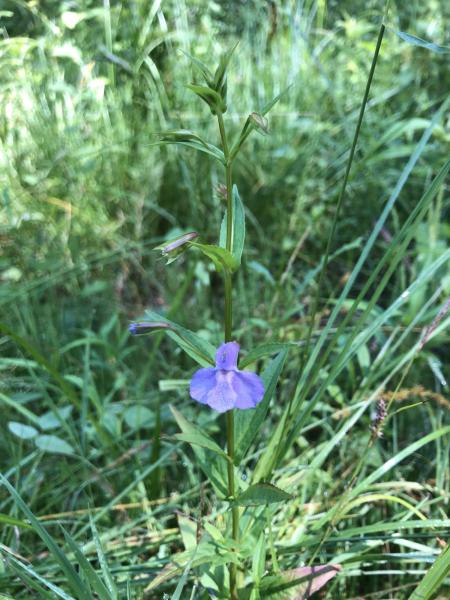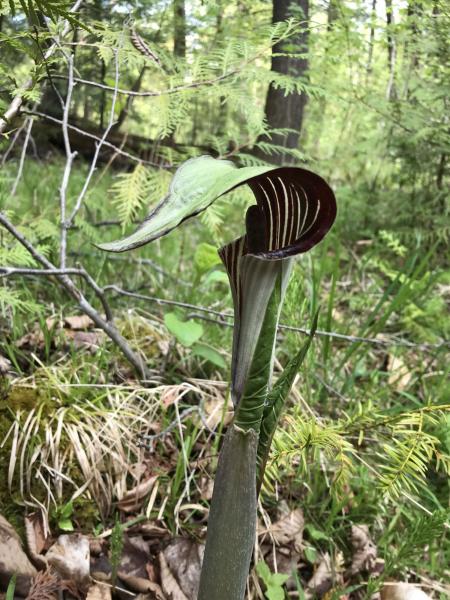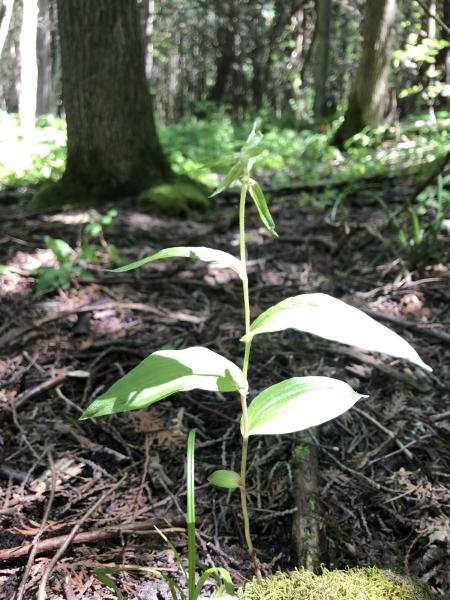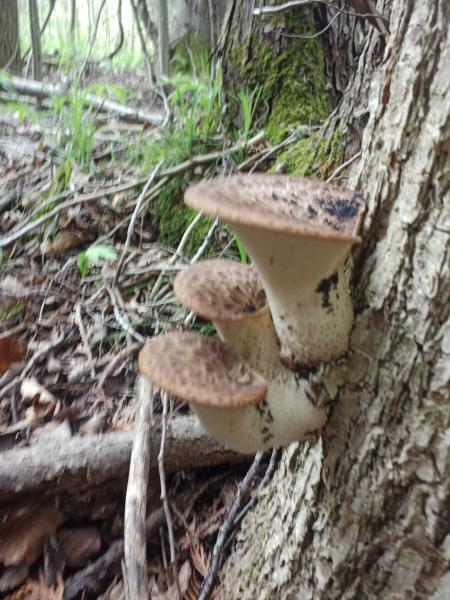
Pottageville Waabashkiki Wendaajiwanong Akiing
Location
GPS Coordinates
The Pottageville Swamp complex is a 979.52 hectares of provincially significant wetland that is composed of a mosaic of swamps, forests, and marshes. It serves as the source of many tributaries that flow into the Holland River. The Holland River itself flows north and empties into Lake Simcoe. The Holland River floodplains support the Holland Marsh wetland complex, which is a larger area of wetland, covering approximately 8,500 hectares, located on the south shore of Lake Simcoe. Pottageville Swamp was once connected to the Holland Marsh but is now isolated due to extensive wetland draining for agricultural development that occurred during the European settlement of Ontario. Currently, Pottageville Swamp consists of a mix of private and public lands. A portion of the swamp is owned and managed by the Lake Simcoe Region Conservation Authority as a nature reserve, which is not open to the public.
Treed swamp forms the most abundant vegetation cover of the Pottageville Swamp complex. Swamps are treed plant communities that grow on persistently moist to waterlogged soils, and experience seasonal flooding and water pooling, and have a general Ph of between 4 and 7. Within the nature preserve, common swamp tree associations include red maple, cedar, basswood, and white ash as the predominant canopy species, with lesser abundances of black cherry, yellow birch, slippery elm, blue beech/musclewood, black ash, swamp oak, and balsam fir. Common sub-canopy and shrub species include chokecherry, buckthorn, black maple, trembling aspen, swamp honeysuckle, red elderberry, white meadowsweet, swamp current, balsam poplar, and grapevine. Ferns, sedges, and wildflowers are abundant on the swamp floor, including species such as sensitive fern, lady fern, wood fern, Jack-in-the-pulpit, blue cohosh, trout lily, Canada mayflower, bloodroot, early meadow rue, red trillium, violets, anemones, agrimony, jewelweed, field mint and hog peanut.
Other treed swamp types include silver maple-deciduous stands, which co-occur with moonseed in the understory, as well as tamarack and black spruce coniferous swamps. These more acidic coniferous swamps are associated with species that are characteristically common in boreal forests, such as swamp birch, Labrador tea, creeping snowberry, orchids, and pitcher plants.
Marshes characterized by cattails, grasses, and sedges also occur in patches throughout the swamp complex. These marshes are often bordered by thicket swamps composed of speckled alder or red osier dogwood.
Twenty-two archaeological sites have been registered in the Pottageville Swamp-Holland Marsh lowlands that date to the Paleo-Indian, Early Archaic, and Middle Archaic periods, suggesting continual Indigenous occupation since the end of the last glacial period, approximately 10,000 BCE. During the Paleo-Indian period (10,000 to 8000 BCE), villages were focused on the northern and southern tips of the Holland Marsh, especially along the banks of Kettleby Creek, which is a tributary of the Holland River. Settlements became more diffuse and scattered throughout the Pottageville Swamp-Holland Marsh complex throughout the Archaic periods (8000-500 BCE) and moved away from the marsh and onto higher ground, such as the nearby Oak Ridges moraines, during the Woodland Period (500 BCE to 1500 CE).
The Pottageville Swamp-Holland Marsh area is located on the northern terminus of an ancient Indigenous overland traveling route and portage called the Toronto Carrying Place. The Toronto Carrying Place connected the north shore of Lake Ontario to the Holland River, after which people could travel by water to Lake Simcoe, Georgian Bay, and beyond. Prior to the arrival of the first European settlers, the south shore of Lake Simcoe was the homeland of the Huron-Wendat Confederacy (also spelled Huronne-Wendat, Wyandotte, and Wyandot). After the 1650s, the Huron-Wendat Nation moved east to Wendake in Québec, and members of the Huron-Wendat people joined other nations, including the nations of the Three Fires Anishinaabe confederacy and the Haudenosaunee confederacy. All these Indigenous nations used the Toronto Carrying Place. Oral and written accounts from the time of early European exploration recall that travelers on the Carrying Place would re-embark on their canoes at Pottageville Swamp and push through to the Holland River.
The north end of the Toronto Carrying Place has historically been an important area for the conduct of trade and diplomacy between Indigenous nations. One particularly important site, which was called the Lower Landing in the early accounts of fur traders and colonial officials, was located northeast of Pottageville Swamp, near modern day Bradford West Gwillimbury. Although the specific geographical coordinates of the Lower Landing have been lost to time, we know that it was on the east bank of a curve on the east branch of the Holland River. Meetings between different Indigenous nations were conducted at the Lower Landing site, and during the early fur trade, a trading post, which was called Pine Fort, was erected at Lower Landing where French, English, and Indigenous traders converged to conduct business. At the height of its operation, 30 wigwams were clustered on high ground overlooking Pine Fort.
The Pottageville Swamp-Holland Marsh area was transferred to the British crown through three treaties; the Toronto Purchase of 1787 (covering Toronto and York Region up to King Township), the Johnson-Butler Treaty of 1787-1788 (York Region) and the Nottawasaga Purchase of 1818 (covering Simcoe County). During the early years of the formation of Upper Canada, the distribution of annual payments and gifts to the Chippewa Nations in fulfillment of treaty terms were carried out at Lower Landing. Lower Landing was used as a docking port for large boats and steamers, which brought goods to support the establishment of early Euro-Canadian settlements on the south shore of Lake Simcoe. Fort Gwillimbury, which was constructed over the original fur trading post at Lower Landing, was used for the storage of naval and military equipment during the war of 1812. However, soon after the war of 1812, Lower Landing quickly fell into disuse.
In 1979, Archaeological Services Inc. (ASI) conducted a stage 2 archaeological assessment along the proposed route of a new highway connecting Highway 404 and Highway 400, north of Bradford, Ontario. During the assessment, ASI identified a site in East Gwillimbury, given the code BaGv-42, which yielded a high volume of artifacts of Indigenous and Euro-Canadian significance. A subsequent stage 3 excavation was conducted. The majority of artifacts found during the excavation were ceramic shards and bone and chert tools. Other artifacts include stone tools and bone fragments. The dating of these tools suggests that occupation of the site began during the middle Archaic Period (6000 to 4000 BCE), with the height of occupation during the middle Woodland Period (400 BCE to 600 CE). Post-contact objects of Euro-Canadian origin, including creamware and pearlware ceramic shards, glass beads, pipes, gunflints, and an English metal axe, were also recovered. Due to the findings of the stage 3 excavation, there is speculation that BaGv-42 may be the Lower Landing site, though archaeologists suggest that more evidence is needed to know for certain.
Lake Simcoe Region Conservation Authority Nature Preserves: Nature Preserves - Lake Simcoe Region Conservation Authority (lsrca.on.ca)
| English | Latin | Kanienʼkéha | Anishinaabemowin |
|---|---|---|---|
| Yellow Birch | Betula alleghaniensis | tsyotsyó:ren | wiinizik (-oog, plural) |
| Wild Strawberry | Fragaria virginiana Duchesne | ken’niiohontesha, niyohentéhsha’, niyohontéhsa, ken’niyohontésha | odeimin (-an, plural) |
| White Ash | Fraxinus Americana | káneren | aagimaak, bwoyaak |
| Black Ash | Fraxinus nigra | éhsa | baapaagimaak, bwoyaak |
| White Cedar | Thuja occidentalis | onen’takwehtèn:tshera | giizhigaa'aandak, giizhik |
| Balsam Fir | Abies balsamea | otshohkó:ton | zhingop |
| Red Maple | Acer rubrum | ka’takén:ra | zhiigmewanzh, zhiishiigimiiwanzh (-iik, plural) |
| Hog Peanut | Amphicarpaea bracteata | yohso'kwa'a | bagwadj'miskodi'simin |
| Wild Sarsaparilla | Aralia nudicaulis | tsyotere'se'kó:wa, yonekó:wa, tsyawenséhsha, otsyawénhsa | waaboos-odji-bik, waabooz jiibik |
| Burdock | Arctium lappa | ohrohte’kó:wa | zagdebwe, zadebwe |
| Jack-in-the-pulpit | Arisaema triphyllum | tyehnónhserote, kyehnónserote, kárhon, tsyorákares, tsorákares, kahnéhserote, okwá:rot nikarhonksherá:'a | zhaashaagomin |
| Lady Fern | Athyrium felix-femina | yetskarónhkwa | a' sawan, naanaaganashk (-oon), mzise miijim |
| Yellow Birch | Betula alleghaniensis | tsyotsyó:ren | wiinizik (-oog, plural) |
| Musclewood | Carpinus caroliniana | yotenakaratí:wen | Ska’ agon-mins, Shka agonmins |
| Blue Cohosh | Caulophyllum thalictroides | karhakón:ha, kahrhatakon | kwemshkiki, be'cigodji'bigak, bezhigojiibik, zhiigimewibag |
| Red Osier Dogwood | Cornus sericea | onekwén:tara niwatahtsherò:ten, o’seranekwénhtonh, watatshero:'ten, onekwénhtara niwatatsherò:ten | miskwabi 'mik, mskwabiimnagohns, miskwaabiimizh "red shrub" Cornus sericea |
| Meadow Horsetail | Equisetum pratense | aweyó:ta | aanikawishkoons, zhiishiibinashk |
| Trout Lily | Erythronium americanum | skatsihstóhkonte | namegbagoniin |
| Wild Strawberry | Fragaria virginiana Duchesne | ken’niiohontesha, niyohentéhsha’, niyohontéhsa, ken’niyohontésha | odeimin (-an, plural) |
| White Ash | Fraxinus Americana | káneren | aagimaak, bwoyaak |
| Black Ash | Fraxinus nigra | éhsa | baapaagimaak, bwoyaak |
| Spotted Jewelweed | Impatiens capensis | ietsi'erorókhstha, yetsi'erorókhstha | gzhiibosegaateaa, makikiibag, wesa’wasga’skonek, ozaawashkojiibik |
| Starry Solomon’s Seal | Maianthemum stellatum | kítkit o'éta | agongseminan, agongosimizh, agong’osiminan |
| Wild Mint | Mentha arvensis | ye’tonhkwanóhstáhkwa, ie'tonhkwanohstáhkwa', kanóhstha | namewack, aandek-bagoohnsean |
| Sensitive Fern | Onoclea sensibilis | tsyohtehrí:seron | a’nana’ganak, naanaaganashkoon |
| Common Yellow Woodsorrel | Oxalis stricta | teyoratu teyorá:ton | ziiwanabagashk |
| Virginia Creeper | Parthenocissus quinquefolia | kontiráthens | mnidoo- biimaakwad bebaamooded |
| Downy Solomon’s seal | Polygonatum pubescens | kítkit o'éta | agongseminan, agong’osiminan |
| Balsam Poplar | Populus balsamifera | (check this) | azaatii, maanzaatii, man'asa'di |
| Trembling Aspen | Populus tremuloides | onerahtón:ta, o’nerahtón:ta, orahaton takorokwa | azaadi, azaadiins, azaadiins, azaadiig, zaad, zaat |
| Black Cherry | Prunus serotina | é:ri, e:ri’kó:wa, tyotyò:ren | ookweminagaawanzh, ookweminan, ikwe'mic |
| Chokecherry | Prunus virginiana | tyakonya’tawén:’eks, teyakonya’tawén:’eks | asasaweminagaawanzh, asasaweminan, baakinminaan, asasaweminogaawangh |
| Red Oak | Quercus rubra | karíhton | miskode-miizhmizh, mitig mewish (-iik plural) |
| Black Swamp Gooseberry | Ribes lacustre | tyorenatsí:yo, ohrá:ton, anáduma:o:náhi | zhaabo-miinashkoon, zhaaboomin (-aak, plural), me’skwacabo’minak, kaawe-saba |
| Red Elderberry | Sambucus racemosa | ahrhakéha | papashkisiganak (-oon, plural) |
| Bloodroot | Sanguinaria canadensis | tekanekwas, tekané:kwaks, tekanekwénhshya'ks | miskwi- chiibikoon |
| Sassafras | Sassafras albidum | wenhnákeras | menaagwaakmizh, menagwake miins |
| Zig-zag Goldenrod | Solidago flexicaulis | otsí:nekwar niyotsi’tsyò:ten | ajidamoowaanow, waabanoominens/waabanoominensag, giizisso mashkiaki |
| New England Aster | Symphyotrichum novae-angliae | teyonerahtawe'éhston, yotsiron’onhkóhare orón:ya | waanisikensiwang |
| Dandelion | Taraxacum officinale | tekaronhyaká:nere | mindemoyanag, doodooshaaboojiibik, mindimooyenh, wezaawaaskwaneg |
| Early Meadow Rue | Thalictrum dioicum | otsi’tsyakérha | (check this) |
| White Cedar | Thuja occidentalis | onen’takwehtèn:tshera | giizhigaa'aandak, giizhik |
| Basswood | Tilia americana | ohóhsera | wiigobiish, wiigob, wiigobiig (plural) |
| Red Trillium | Trillium erectum | tsyonà:tsya onekwénhtara niyotsi’tsyò:ten, áhsen niioneráhtonte | moonigohn, ininiiwindibiigegan, ini'niwin'digige'gun |
| Eastern Hemlock | Tsuga canadensis | onen’ta’ón:we | gaagaaimizh, baagoodag, mitg, gaagaagiwa/inzh |
| Slippery Elm | Ulmus rubra | akará:tsi | ozhaashigob |
| Labrador Violet | Viola labradorica | tekonnyarotárhoks, tekonteniarotáhrhoks, tewatenyarotárhos | we-waawiyeyaa-bagak, wewaie’bagag |
| Common Blue Violet | Viola sororia | tekonnyarotárhoks, tekonteniarotáhrhoks, tewatenyarotárhos | we-waawiyeyaa-bagak, wewaie’bagag, ozhaawashkwaabigwan "blue or green flower/s) |
| Wild Grape | Vitis riparia | o’nénhare | zhoominan, jo’minaga’wanj |
| Cockspur Hawthorn | Crataegus crus-galli | ohì:kta wahyarà:ken; yotironhwentsí:yo | miinensgaawanzh |
| Swamp White Oak | Quercus bicolor | otokénha | mtig- mizh |




